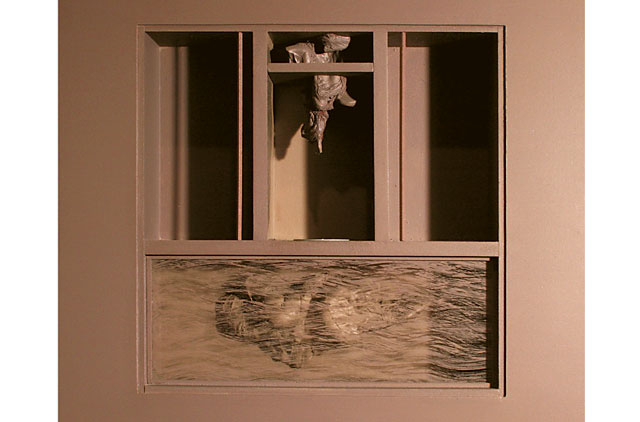
The protests that sparked the Arab Spring are reverberating around the world now. What began as a personal act of anger has developed into a global movement for change. At this moment in our history, the world seems to be very fragile, and this fragility has seeped into the collective consciousness. How have artists responded to these upheavals and transformations around the world? And how are these rapid changes being recorded in the art of the times? Curators Malini Gulrajani and Vida Heydari invited young artists from India, Iran and Pakistan to answer these questions in an exhibition titled Fragile. The show expresses the individual experiences, concerns and perspectives of the artists.
The viewpoint of the Iranian artists is influenced both by the developments in this region and the situation in their own country. Alireza Fani's staged photographs, titled A Memorial For Today, question the passive attitude of people. His pictures depict people involved in everyday activities, such as having a meal, meeting friends or watching television. But their eyes are closed. The images appear to ask whether by passively accepting our situation, we have turned a blind eye to our alternatives. What Fani seeks to convey is that rather than blaming others, it is up to us to open our eyes and take responsibility for our lives.
Mohsen Sadeghian's wooden boxes are inspired by classical Iranian poetry, literature, architecture and religious tradition, but have a palpable sense of anger, frustration and desperation. The uneven compartments, dark spaces and bars inside the boxes reflect the compartmentalisation of and restrictions in Iranian society. And the twisted and compressed bodies, lying inert, suspended precariously or concealed behind painted glass, are a comment on the suppression of individual freedoms. These dark artworks are as much about oppressive regimes as the will of individuals to rise above their fears and limitations and find within themselves the courage to fight for their freedom and dignity.
Samira Nowparast chooses to escape to a fantasy world through paintings of horses and cows in lush green environs. But the mathematical calculations and drawings of man-made machines in her paintings are a reminder of the ugly reality around her. "There are no humans in this timeless utopia, but you can see their tracks. The tracks lead me to man-made things, such as razors, gearwheels or parts of unidentified machines, that challenge the blissful creatures of my paintings," she says.
Indian artist Parul Thacker has also created an imaginary place — a City of Light — by using healing crystals to ease the turmoil within herself and in the world. The crystals are entwined with nylon thread to create interesting three-dimensional artworks. "The thread looks fragile but it is strong like my faith. It binds the crystals together to form a map of a city of light and positive energy that lies beyond our terrestrial existence. For me, this process is just the beginning, and my aim is to create not just one city of light but a city that grows into a region, which enlarges to cover the Earth and spreads its light on the entire universe," she says.
Shivani Agarwal tries to define fragility through transience. She uses painted and photographic images, metaphoric references, and the positioning of the many small canvases that make up her artworks to capture changing moments and feelings. "The red thread in my images is a metaphor for the transient nature of things, people, situations and emotions. It entangles, binds, takes on different forms around different objects and changes constantly to depict the dichotomy of attachment and separation, bondage and freedom. I work with multiple images to express the idea of change and movement. I am trying to gather our fragile, ever-changing thoughts and feelings, and knit them into a story so that we can deal with them and preserve them," she says.
Prajakta Palav Aher's layered works draw parallels between fragility and pregnancy. Both states are delicate, but hold a lot of promise for the future. Pooja Iranna presents man-made structures as a symbol of human presence, emotions, and physical and mental strength. Her latest work includes huge wall-like sculptures with doorways made from coloured stapler pins. "These structures symbolise the shaping of human life. They are about the building of intellectual and spiritual character of people. The staples joined together signify the strength and energies of people coming together to create a structure that is strong on the surface and has the vigour of human convictions within. Thus they represent human endeavour to make life harmonious from the inside and outside," she says.
Pakistani artist Kaif Ghaznavi goes back to his roots to depict the present situation. His photographs are based on the rural tradition of women making a different parting in their hair every day of the lunar month as a way of physically mapping time. "The changing partings reflect situations of transition, uncertainty, fear, pleasure, pain and endurance," he says.
Jyoti Kalsi is an art enthusiast based in Dubai.
Fragile will run at 1X1 art gallery, Al Quoz, until January 30, 2012.













